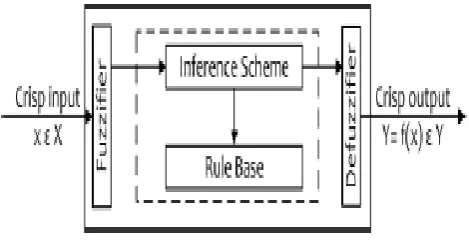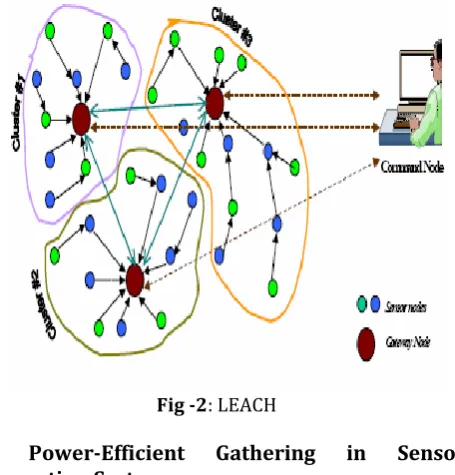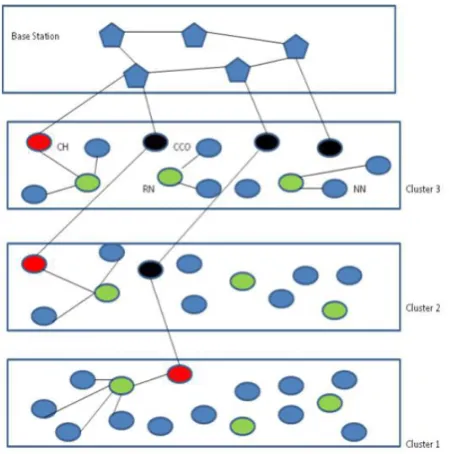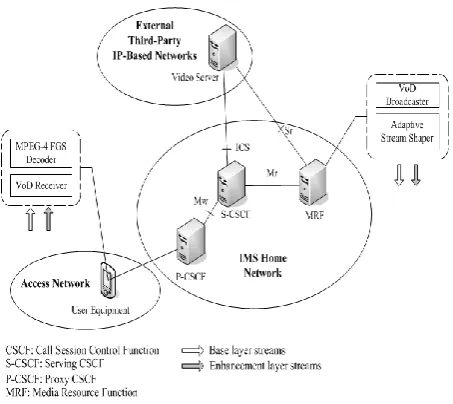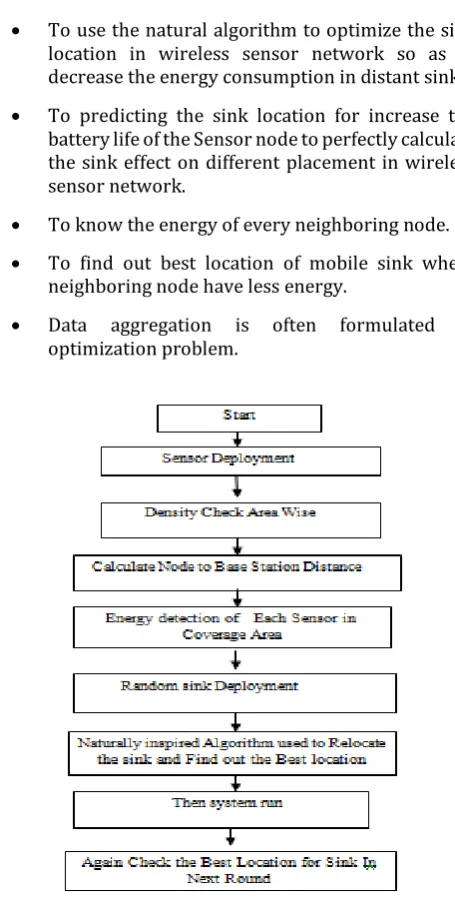© 2018, IRJET | Impact Factor value: 6.171 | ISO 9001:2008 Certified Journal | Page 651
Review on New Energy Efficient Cluster Based Protocol for Wireless
Sensor Networks
Ravneet Kaur
1, Dr. Parveen Singla
21M. tech Student, Dept. Electronics & Communication Engineering, Chandigarh Engineering College, Punjab, India
2Associate Professor, Dept. of Electronics & Communication Engineering, Chandigarh Engineering College,
Punjab, India
---***---Abstract - Wireless-sensor networks are networks of
autonomous nodes used for monitoring an environment. Developers of WSNs face challenges that arise from communication link failures, memory and computational constraints, and limited energy. Many issues in WSNs are formulated as multidimensional optimization problems, and approached through bio inspired techniques. There are many techniques which are simple, effective, and computationally efficient optimization algorithm. It has been applied to address WSN issues such as optimal deployment, node localization, clustering, and data aggregation. So, this thesis work outlines issues in WSNs, introduces biologically inspired algorithm which help us in enhancing the battery life of the Sensor nodes, and discusses its suitability for WSN applications. It also presents a brief survey of how the biologically inspired algorithms are tailored to address these issues. Bio inspired optimization methods are computationally efficient alternatives to analytical methods.
Key Words: Wireless sensor networks, LEACH and PEGASIS
1.INTRODUCTION
In wireless sensor network, we consist small-size sensor devices which can use limited battery power. when Wireless sensor network is deployed in sensing area then it collects only abnormal data and send to special node called sink. The sensors in a Wireless sensor network are not capable to be recharged when their battery drain out of power which causes several problems such as communication hole etc. so that is why we use approaches for consumption like to use mobile sensors to adjust their location from high energy level to low energy level. A mobile sink is relocated its position rather than sensor node. In Wireless sensor network, we have two routing protocol static and dynamic. In static routing protocol the sensor node sends the data with predefined path to the sink. but in dynamic protocol the path can be defined for transmitted the data to current state of the sensor node, therefore it can balance the load on each sensor node, we use maximum capacity path, which increase the network lifetime. In wireless sensor network, when stationary Wireless sensor network is deployed in a sensing area, every sensor node has fixed position and sensing the data hop by hop due to which sensor node drain out their battery energy. but in relocate Wireless sensor network, the mobile sensor can relocate their location when sensor node
drains out their total energy. Over the past few year, we use different techniques. In Energy Aware Sink Relocation, we find out the transmission range of each sensor node.
According to their residual battery energy it consists transmission range & sink relocation. Particle Swarm Optimization is a simple, effective and computationally efficient optimization algorithm. In Particle Swarm Optimization algorithm, a swarm of particle starts to fly in search space, then we calculate the performance of each particle according to their objective function. Particle having best experience stored in a memory called personal best. The personal best set the value of global best.
2. LITRATURE SURVEY
Different approaches have been proposed to look the issues of WSNs. Some of the following are as
2.1 A Hybrid Energy Aware Routing Algorithm for Wireless Sensor Networks
Azeddine Bilami, Djallel Eddine Boubiche targets the one of the weakness of wireless sensors networks that is the limit of energy which affects network’s lifetime. To increase the lifetime of the sensor network, a new routing approach which combines two algorithms: LEACH and PEGASIS. In our proposal, nodes belonging to the same cluster form a chain where nodes communicate only with their closest neighbors, so that energy dissipation within clusters can be minimized and consequently, lifetime of the network can be improved. Simulations using Network Simulator ns2 have been conducted to study the behavior of our routing algorithm.
[image:1.595.311.546.619.740.2]© 2018, IRJET | Impact Factor value: 6.171 | ISO 9001:2008 Certified Journal | Page 652 2.2 Sensor Network Hybrid Routing Protocol for
Prolonged Network Lifetime in Large Scale Wireless
M. Tabibzadeh, M. Sarram, F. Adibnia introduced the Chain based LEACH protocol in sensor networks have limited energy and in large-scale sensor networks, communication between sensor nodes is necessary to cover a large monitoring region, thus energy preserving techniques are important. A hybrid protocol, which we will call collectively Chain-based LEACH that improves the Low-Energy Adaptive Clustering Hierarchy to significantly reduce energy consumption and increase the lifetime of a sensor network. Our protocol uses LEACH and the advantages of Power-Efficient Gathering in Sensor Information Systems and avoids their disadvantages. LEACH technique improves energy efficiency of a sensor network by selecting a cluster-head, and having it aggregate data from other nodes in its cluster, and PEGASIS is a near optimal chain-based protocol that we used for communication and extra aggregation between cluster-heads that are neighbors and takes turns transmitting to the sink. Simulation results show that CBL performs better than LEACH.
Fig -2: LEACH
2.3 Power-Efficient Gathering in Sensor Information System
Stephanie Lmdsey and Cauligi S. Raghavendra Proposed the Sensor webs consisting of nodes with limited battery power and wireless communications are deployed to collect useful information from the field. Gathering sensed information in an energy efficient manner is critical to operate the sensor network for a long period of time. In data collection problem is defined where in a round of communication, each sensor node has a packet to send to the distant base station. If each node transmits its sensed data directly to the base station then it will deplete its power quickly. The Leach protocol presented in an elegant solution where clusters are formed to fuse data before transmitting to the base station. By
randomizing the cluster heads chosen to transmit to the base station, Leach achieves a factor of eight improvement compared to direct transmissions, as measured in terms of when nodes die. Power-Efficient Gathering in sensor information systems, a near optimal chain-based protocol that is an improvement over LEACH. In PEGASIS, each node communicates only with a close neighbor and takes turns transmitting to the base station, thus reducing the amount of energy spent per round.
Fig -3: Clustered wireless sensor network
2.4 Distributed Data Gathering Scheduling in Multihop Wireless Sensor Networks for Improved Lifetime
Subhasis Bhattacharjee and Nabanita Das proposed algorithm significantly outperforms the scheduling based on the Minimum Spanning Tree (MST), or the Shortest Path (SP) routing techniques for a multihop sensor network with _ sensors, this paper presents the distributed greedy algorithm for extracting a rooted spanning tree to improve the lifetime of the overall network. It spontaneous determines a data gathering schedule from the sensors towards the base station the root. No global knowledge about the topology is required for the computation and also each sensor does not need to access the base station directly. Simulation studies show that in terms of system lifetime, the proposed algorithm significantly outperforms the scheduling based on the Minimum Spanning Tree (MST), or the Shortest Path (SP) routing techniques. Performance comparison with PEGASIS shows that the proposed algorithm performs better as more and more nodes die out
2.5 Lifetime Enhancement in Wireless Sensor Networks through Selective Data Handover
[image:2.595.311.555.205.340.2] [image:2.595.53.281.366.604.2]© 2018, IRJET | Impact Factor value: 6.171 | ISO 9001:2008 Certified Journal | Page 653 While the Leach protocol randomizes cluster heads for equal
energy dissemination, the PEGASIS protocol forms a chain of cluster heads taking rounds in transmitting to the base station. The binary hierarchical model also addresses this issue. We propose Data Handover Scheme which enhances the performance of LEACH, PEGASIS and binary model in terms of network lifetime. The base station being located at variable distances from the individual nodes, in spite of randomization and chain formation, each node actually dissipates a different amount of energy during its turn of transmission to the base station. This energy difference increases as the base station is located further off from the sensed area and linearly with the number of cycles elapsed and the packet length. DHS eliminates this energy difference by data handover in specific cycles through suitable node pairing and partner swapping.
2.6 Coverage Lifetime Improvement in Wireless Sensor Networks by Novel Deployment Technique
Niharika Gupta, Mohammad Wazid, Seepaj Sharma, D P Singh, R H Goudar introduced the coverage means how well a sensor network will monitor the total area of the region. Node deployment is one of the important issues that need to be solved. The number of sensor nodes has direct impact on the cost of the Wireless Sensor Networks. So, keeping this in mind, the proper deployment of nodes can reduce the complexity of problems, energy consumption can be reduced and thus extends the lifetime of the Wireless Sensor Networks. We are considering the tactical environment, so the deployment of sensor node becomes random. We are forming the tessellation of the deployment as Rhombus other than Triangle, Square and Hexagon that are taken ideally for deploying the sensor nodes and after applying the proposed method the lifetime of the given network increases.
Fig -4: Multihop Wireless sensor network
2.7 A Hybrid Approach for Data Collection and Sensor Redeployment Using Mobile Element in Wireless sensor networks
Jiaxing Xiao, Ruonan Zhang, Jianping Pan, and Yi Jiang Proposed the data collection schemes in wireless sensor network, have been intensively studied in the decade yet still a very active area. A number of schemes, such as the multihop data forwarding and the mobile element gathering, have been proposed. In the majority of the literatures, the full sensing field coverage and network connectivity are usually ignored or assumed to be true. However, such conditions may not be satisfied in reality due to the random deployment of the sensor nodes over the target area. In this paper we jointly consider the network connectivity, field coverage and data collection, and propose a hybrid approach called cluster based mobile element scanning and redeployment to achieve these goals simultaneously. CMESR combines the intra cluster data gathering and the ME harvesting to collect data and redeploy SNs adaptively. Furthermore, the mechanisms of low overhead multihop routing, redundant sensing and transmission avoidance, dynamic cluster-head selection and SN redeployment is provided. The performance of CMESR is simulated extensively and compared to other cluster-based schemes such as LEACH, BCDCP and PEGASIS. The results have shown that using CMESR, not only the energy consumption is significantly reduced and balanced among the SNs, but also the latency is minimized.
2.8 Maximum Life-time Broadcast Protocol for Wireless Sensor Networks
[image:3.595.49.274.518.745.2]© 2018, IRJET | Impact Factor value: 6.171 | ISO 9001:2008 Certified Journal | Page 654 Fig -5: Broadcast protocol for wireless sensor network
A New Routing Algorithm for Energy Reduction in Wireless Sensor Networks Keyhan Khamforoosh, Hana Khamforoush, Branch Sanandaj, Sanandaj, Iran Proposed the protocols in Wireless sensor networks are set of thousands or more micro sensor nodes that one of the most important constraints of them is energy consumption of these sensor nodes. Since these nodes have very small dimensions, energy production needs batteries with limited power. It is obvious that the problem of energy reduction was always one of the biggest challenge in these networks. In these networks, routing is data-centric. On the other hand, in these networks it is only important to receive the data packet by the BS. In this paper we propose a new method for routing in wireless sensor networks that instead of using the traditional routing methods attempts to add nodes which have the minimum distances from each other. In our innovative method, we define node arrangement such that always data packets which are sent, arrive to destination through the shortest path which cause to reduce the total energy consumption. Since the sensor nodes which are near to each other have many redundant data, we can aggregate data packet continuously in the network.
3. IMPLEMENTATION
Due to large distance between nodes, when nodes transmit data from transmitter to receiver, network has more than one path. But network chooses the shortest path to send data. Sometimes path is shortest but the distance between the nodes is large, due to this large energy is consumed. If each node transmits its data directly to the sink, some nodes that are far away from the sink, will die much earlier than the other sensor nodes. This is as a result of rapid energy depletion due to long distance data transmission. The depleting speeds of battery energy of sensor nodes will significantly affect the network lifetime of a WSN. Most researchers have aimed to design energy-aware routings to conserve the usage of the battery energy to prolong network
lifetimes. A re-loadable sink is another approach for prolonging network lifetime by avoiding staying at a certain location for too long which may harm the lifetime of nearby sensor nodes. This approach can not only relieve the burden of the hot-spot, but can also integrate the energy-aware routing to enhance the performance of the prolonging network lifetime
3.1PEGASIS Cluster based Routing Protocol
[image:4.595.49.276.82.284.2]© 2018, IRJET | Impact Factor value: 6.171 | ISO 9001:2008 Certified Journal | Page 655 To use the natural algorithm to optimize the sink
location in wireless sensor network so as to decrease the energy consumption in distant sinks. To predicting the sink location for increase the battery life of the Sensor node to perfectly calculate the sink effect on different placement in wireless
sensor network. To know the energy of every neighboring node.
To find out best location of mobile sink where neighboring node have less energy.
Data aggregation is often formulated as optimization problem.
Fig -6: Methodology
4. CONCLUSIONS
In a wireless sensor network (WSN), the area around the Sink forms a bottleneck zone where the traffic flow is maxi- mum. Thus, the lifetime of the WSN network is dictated by the lifetime of the bottleneck zone. Distributing the energy load among the nodes increases the lifetime and quality of the network. Our simulations show that PEGASIS performs better than LEACH by about 100 to 300% when 1%, 20%, 50%, and 100% of nodes die for different network sizes and topologies. PEGASIS shows an even further improvement as the size of the network increases. In order to verify our assumptions about PEGASIS, we will extend the network simulator ns-2 to simulate PEGASIS, LEACH, and direct transmission protocols. Based on our C simulations, we expect that PEGASIS will outperform the other two protocols in terms of system lifetime and the quality of the network.
ACKNOWLEDGEMENT
The author wishes to express their sincerest thanks to Dr. Parveen Singla for their guidance in my research work.
REFERENCES
[1] ‘’A Hybrid Energy Aware Routing Algorithm for Wireless
Sensor Networks’’ 2008 by Azeddine Bilami, Djallel Eddine Boubiche.
[2] ‘’Hybrid Routing Protocol for Prolonged Network
Lifetime in Large Scale Wireless Sensor Networ’’2009 by M. Tabibzadeh, M. Sarram, F. Adibnia
[3] ‘’Power-Efficient Gathering in Sensor Information’’2001
by Systems’Stephanie Lmdsey and Cauligi S. Raghavendra.
[4] ‘’Distributed Data Gathering Scheduling in Multihop
Wireless Sensor Networks for Improved Lifetime’’2007 by Subhasis Bhattacharjee and Nabanita Das.
[5] ‘’Lifetime Enhancement in Wireless Sensor Networks
through Selective Data Handover’’2007 by Abhishek Bhattacharyya, Anand Seetharam, Sulagna Dasgupta, Debjyoti Das, Swarup Mitra, M.K.Naskar.
[6] ‘’Coverage Life Time Improvement in Wireless Sensor
Networks by Novel Deployment Technique’’2013 by Niharika Gupta1, Mohammad Wazid2, Seepaj Sharma3, D P Singh4
[7] ‘’A Hybrid Approach for Data Collection and Sensor
Redeployment Using Mobile Element in Wireless sensor networks’’2013 by Jiaxing Xiao, Ruonan Zhang, Jianping Pan, and Yi Jiang.
[8] ‘’Maximum Life-time Broadcast Protocol for Wireless
Sensor Networks’’2010 by Ruiqin, Zhao, Xiaohong, Shen, Xiaomin Zhang.
BIOGRAPHIES
Ravneet Kaur received the B.Tech degree in Electronics & Communication Engineering from Desh Bhagat Engineering College in 2015 and is
currently pursuing M.Tech in
Electronics & communication
Engineering from Chandigarh
[image:5.595.48.276.73.525.2]